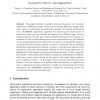Free Online Productivity Tools
i2Speak
i2Symbol
i2OCR
iTex2Img
iWeb2Print
iWeb2Shot
i2Type
iPdf2Split
iPdf2Merge
i2Bopomofo
i2Arabic
i2Style
i2Image
i2PDF
iLatex2Rtf
Sci2ools
MIAR
2006
IEEE
2006
IEEE
A General Learning Framework for Non-rigid Image Registration
This paper presents a general learning framework for non-rigid registration of MR brain images. Given a set of training MR brain images, three major types of information are particularly learned, and further incorporated into a HAMMER registration algorithm for improving the performance of registration. First, the best features are learned from different types of local image descriptors for each part of brain, thereby the learned best features are consistent on the correspondence points across individual brains, but different on non-correspondence points. Moreover, the statistics of selected best features is learned from the training samples, and used to guide the feature matching during the image registration. Second, in order to avoid the local minima in the registration, the points hierarchically selected to drive image registration are determined by the learned consistency and distinctiveness of their respective best features. Third, deformation fields are adaptively represented by...
| Added | 12 Jun 2010 |
| Updated | 12 Jun 2010 |
| Type | Conference |
| Year | 2006 |
| Where | MIAR |
| Authors | Guorong Wu, Feihu Qi, Dinggang Shen |
Comments (0)

